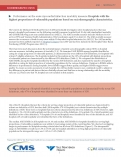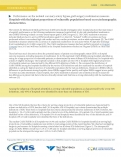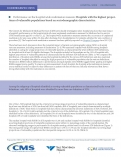Choose a condition/procedure
Choose a Condition:
Then, choose an outcome:
Add a Characterstic
Current Characteristics:
- {[{characteristic.name}]}
{[{ selectedMeasure.condition }]}: {[{ selectedMeasure.description }]} Hospitals with the highest proportion of patients with the following characteristic: {[{selectedVariables[0].name}]} Select at least one sociodemographic characteristic above to begin.
{[{filteredHospitals[0].length}]} out of {[{ allHospitals.length }]} total hospitals in measure
| {[{variable.length}]} | {[{ $index > 0 ? "and" : ""}]} {[{ selectedVariables[$index].name }]}{[{ $index === filteredHospitals.length - 1 ? "" : "..."}]} |
Table View
Notes
Hospitals were identified as caring for disproportionate volume of patients with social risk factors if they were in the highest decile for that definition.
The measurement period for all condition-specific mortality, readmission, and payment measures, and the hip/knee readmission measure went from July 2018 through June 2021. The hip/knee complication measure uses data from April 2018 through March 2021. The hospital-wide readmission measure uses data from July 2020 through June 2021.
Social risk factors were derived from the American Community Survey (ACS) 5-year estimate: 2013 - 2017, the American Hospital Association (AHA) Survey 2018, and the Medicare Part A Inpatient Claims 2018.
Only hospitals with at least 25 qualifying hospitalizations for a given measure are included in the visualization.
Beginning with the 2019 reporting year, the stroke readmission measure was removed from this data visualization because this measure is no longer reported in the Inpatient Quality Reporting Program (IQR). This measure’s results are still available in reporting years prior to 2019.
Table 1. Key Definitions
|
Social Risk Factor |
Definition |
|
Below U.S. poverty line |
|
|
Educational attainment below high school |
|
|
Unemployed |
|
|
Crowded households |
|
|
African-American |
|
|
Medicaid |
|
|
AHRQ Index of SES score |
|
Methodology Sources
AMI, COPD, Heart Failure, and Pneumonia Readmission Measures Methodology: DeBuhr J, McDowell K, Grady J, et al. 2023 Condition-Specific Measures Updates and Specifications Report Hospital-Level 30-Day Risk-Standardized Readmission Measures: Acute Myocardial Infarction – Version 16.0, Chronic Obstructive Pulmonary Disease – Version 12.0, Heart Failure – Version 16.0, Pneumonia – Version 16.0. https://qualitynet.cms.gov/inpatient/measures/readmission/resources Available as of Spring 2023.
CABG and Hip/Knee Arthroplasty Readmission Measures Methodology: DeBuhr J, McDowell K, Grady J, et al. 2023 Procedure-Specific Measures Updates and Specifications Report Hospital-Level 30-Day Risk-Standardized Readmission Measures: Isolated Coronary Artery Bypass Graft (CABG) Surgery – Version 10.0, Elective Primary Total Hip Arthroplasty (THA) and/or Total Knee Arthroplasty (TKA) – Version 12.0. https://qualitynet.cms.gov/inpatient/measures/readmission/methodology Available as of Spring 2023.
AMI, COPD, Heart Failure, Pneumonia, and Stroke Mortality Measures Methodology: DeBuhr J, McDowell K, Grady J, et al. 2023 Condition-Specific Measures Updates and Specifications Report Hospital-Level 30-Day Risk-Standardized Mortality Measures: Acute Myocardial Infarction – Version 17.0, Chronic Obstructive Pulmonary Disease – Version 12.0, Heart Failure – Version 17.0, Pneumonia – Version 17.0, Stroke – Version 12.0. https://qualitynet.cms.gov/inpatient/measures/mortality/resources. Available as of Spring 2023.
CABG Mortality Measure Methodology: DeBuhr J, McDowell K, Grady J, et al. 2023 Procedure-Specific Measure Updates and Specifications Report Hospital-Level 30-Day Risk-Standardized Mortality Measure: Isolated Coronary Artery Bypass Graft (CABG) Surgery – Version 10.0. https://qualitynet.cms.gov/inpatient/measures/mortality/methodology. Available as of Spring 2023.
Hip/Knee Arthroplasty Complication Measure Methodology: DeBuhr J, McDowell K, Grady J, et al. 2023 Procedure-Specific Measure Updates and Specifications Report Hospital-Level Risk-Standardized Complication Measure: Elective Primary Total Hip Arthroplasty (THA) and/or Total Knee Arthroplasty (TKA) – Version 12.0. https://qualitynet.cms.gov/inpatient/measures/complication/resources Available as of Spring 2023.
AMI, Heart Failure, Pneumonia, and Elective Primary Total Hip Arthroplasty (THA) and/or Total Knee Arthroplasty (TKA) Payment Measures Methodology: DeBuhr J, McDowell K, Grady J, et al. 2023 Measure Updates and Specifications Report Hospital-Level Risk-Standardized Payment Measures: Acute Myocardial Infarction – Version 12.0, Heart Failure – Version 10.0, Pneumonia – Version 10.0, Elective Primary Total Hip Arthroplasty (THA) and/or Total Knee Arthroplasty (TKA) – Version 9.0. https://qualitynet.cms.gov/inpatient/measures/payment/resources Available as of Spring 2023.
AMI, Heart Failure, Pneumonia Excess Days in Acute Care Measure Methodology: DeBuhr J, McDowell K, Grady J, et al. 2023 Condition-Specific Measures Updates and Specification Report Hospital-Level 30-Day Risk-Standardized Excess Days in Acute Care Measures: Acute Myocardial Infarction – Version 8.0, Heart Failure – Version 8.0, Pneumonia – Version 7.0. https://qualitynet.cms.gov/inpatient/measures/edac/resources Available as of Spring 2023.
Hospital-Wide Readmission Measure Methodology: DeBuhr J, McDowell K, Grady J, et al. 2020 All-Cause Hospital-Wide Measure Updates and Specifications Report: Hospital-Level 30-Day Risk-Standardized Readmission Measure – Version 12.0 https://qualitynet.cms.gov/inpatient/measures/readmission/methodology Available as of Spring 2023.
Related Research
To view PDF documents you will need the Adobe Acrobat Reader.
-
AMI Mortality: Results by Social Risk Factors
[PDF, 469.05 KB]AMI mortality measure results for hospitals with highest proportions of socially at-risk populations (July 2011 - June 2014)
-
CABG Readmission: Results by Social Risk Factors
[PDF, 187.05 KB]CABG readmission measure results for hospitals with highest proportions of socially at-risk populations (July 2011 - June 2014)
-
Hospital-Wide Readmission: Results by Social Risk Factors
[PDF, 226.26 KB]Hospital-wide readmission measure results for hospitals with highest proportions of socially at-risk populations (July 2013 - June 2014)




